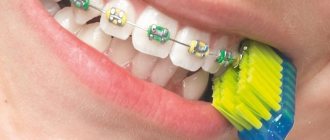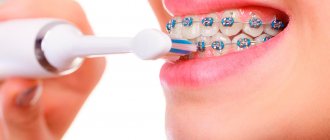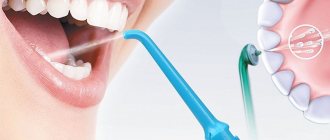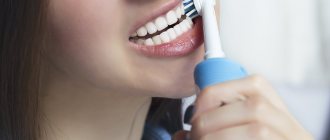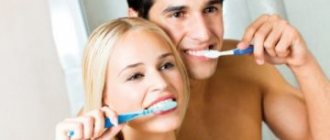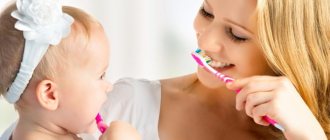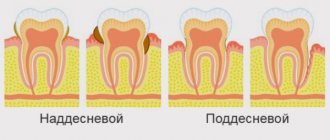The treatment process with an orthodontist requires responsibility from the patient, so you need to follow a number of rules - both in nutrition and in cleaning. The doctor will definitely tell you about this at the appointment. By themselves, neither aligners, nor even obsolete metal braces harm tooth enamel and do not cause caries. Only improper care, including insufficient hygiene, is harmful.
Those who wear aligners or braces need to get used to brushing their teeth constantly.
After eating, small particles of food always remain on the teeth. If it contained carbohydrates, an acidic environment immediately appears in the mouth, harmful to the enamel. But saliva, which has a slightly alkaline reaction, gradually washes away plaque and neutralizes the acid.
If the patient wears braces, this plaque becomes too much, since food gets clogged under the arch and remains around the braces. Saliva will not be able to “neutralize” all the acid. This does not happen with aligners because they are removed for eating. But if you put aligners on teeth that have not been cleaned, the plaque will remain under the aligner, and the acid will also destroy the enamel.
Therefore, all the basic rules during treatment with an orthodontist are related to teeth cleaning.
Cleaning before braces: why is it needed?
Correction of the bite always begins with sanitation of the oral cavity. In addition to treating diseases of the teeth and gums, it includes mandatory professional cleaning before installing braces. The doctor will remove hard deposits with ultrasound, and soft deposits with a thin and powerful jet of cleaning powder solution (AirFlow technology). After this, the teeth will need to be polished with a special paste and coated with a fluoride-containing preparation to strengthen the enamel. Such a hygienic procedure should be carried out 3 - 5 days before installation, but no later than 24 hours.
What happens if you don’t brush your teeth before braces? Bacterial plaque will get under the elements of the system, in particular under the clasps that are glued to the enamel. Considering that orthodontic appliances are worn for a year at best, and two years on average, microorganisms will have enough time to multiply and lead to the formation of caries. It is impossible to properly cure it with braces on the teeth. There is a risk of early removal of the device, and this will spoil the final result, and the patient will waste money, time and moral strength. This is why brushing your teeth before getting braces is mandatory.
What diet should you follow?
There are three main rules that must be followed after installing braces:
- avoidance of excessively hard and “sticky” foods – nuts, seeds, toffees, chewing gums,
- hard fruits and vegetables, meat must be cut into small pieces, chewing with side teeth,
- food and drinks should be warm, but not hot - this can lead to the records coming off.
Your diet should remain unchanged, with the exception of the three points listed. Do not overuse liquid and soft foods - your teeth must receive stress for normal functioning. You can minimize the consumption of viscous foods (chocolate, waffles, chips) - but not because they are prohibited, but because they accumulate on braces and under the archwire. They will simply be very difficult to remove.
Rules for caring for braces after installation
And finally, the orthodontic structure is put on. There are many months, or even years of treatment ahead, during which you will need to devote a lot of time to oral hygiene. Cleaning braces is not an easy task. An orthodontic apparatus is a complex system with many elements: clasps, arches, ligatures, rings, springs, hooks for elastic rods... And on each of them food particles can remain and plaque can accumulate.
Recommendations for caring for the braces system
- You need to brush your teeth at least three times a day, and ideally after every meal, even a small snack.
- It is necessary to brush not only your teeth, but also between them. Dental floss will help clean the interdental space.
- The hygiene of braces must be the most thorough: all elements of the system will have to be processed on each side, avoiding the accumulation of plaque.
- You will have to purchase special brushes for cleaning braces, as well as additional devices such as an irrigator. We will talk about this in more detail below.
- To clean the braces system and teeth, a fluoride-containing paste is used, as well as a fluoride-containing rinse, which completes the oral hygiene procedure with braces.
- It’s best to always carry a toothbrush and floss with you in case you need to eat out.
- For those who wear braces, care and nutrition go hand in hand. During treatment, you will have to give up a number of foods—hard, sticky, fibrous, and anything else that could damage your braces or get stuck in them. You should also significantly limit sweets.
Hygiene of the brace system is a key task for the entire period of wearing an orthodontic device. If it is neglected, whitish spots may appear on the enamel of the teeth - traces of demineralization and the accumulation of bacterial plaque. They look unaesthetic and spoil the impression of the results of long-term treatment.
Why is it so important to brush your teeth?
A malocclusion almost always means that a person has hard-to-reach areas in the oral cavity. They accumulate a large amount of plaque and small particles of food, which can be difficult to clean with a regular brush. Also, the braces themselves hinder proper care, because dirt can also get under the parts of the structure.
For home care, modern manufacturers produce special orthodontic brushes; their bristles have different lengths and shapes; they can have several or one tuft of bristles. Additionally, you can purchase small brushes, an irrigator for treating the oral cavity with strong pressure of liquid, and much more.
However, no home care can compare with professional cleaning in the dental hygienist’s chair. It should be carried out at least once every two to three months, this will help reduce the risk of tartar and enamel caries. Today, there are several methods of safe cleansing, each of which is suitable for patients with and without braces.
Hygiene products for braces
When a person wears braces, oral care consists of several stages. Each of them has its own tool, so the patient will have to acquire a whole arsenal of hygiene products.
Brush for cleaning teeth with braces
The orthobrush has a V-shape with a depression in the center of the pile, which is necessary for treating the surfaces of teeth and most of the orthodontic apparatus. This is where teeth cleaning with braces at home begins. Orthodontists also recommend purchasing a single-tuft toothbrush for cleaning braces. It will be useful for processing distant teeth and the outer part of locks.
Brushes for cleaning braces
It is also necessary to use brushes to clean braces. With their help, it is easy to clean the dental surface under the arcs of the device.
Superfloss
For oral hygiene with braces and cleaning the space between the teeth and around the clasps, you will need a special thread with a hard end - superfloss.
Oral irrigator
Separately, it is necessary to mention the most important device for cleaning braces - the irrigator. The device is somewhat similar to an electric toothbrush, but instead of bristles it has a nozzle from which a powerful stream of water is supplied. The irrigator helps clear plaque from hard-to-reach places where brushes and brushes cannot reach (for example, gum pockets).
Strengthening toothpaste
Wearing braces significantly increases the risk of caries. Therefore, it is worth thinking about prevention. Toothpastes with fluoride, hydroxyapatite crystals, theobromine and other strengthening substances will make your teeth stronger.
What to do if the bracket comes off?
This happens quite rarely. And, as a rule, with budget models that are initially poorly fixed, or after some time after using the system. In such a situation, you need to make an appointment with the orthodontist as quickly as possible, or even come without an appointment during his working hours: gluing the plate will only take a few minutes. Metal braces can be re-glued at least 2-3 times. Ceramic or sapphire - also 1-2 times, but you need to look at their general condition.
It is unlikely that the bracket will be swallowed, since even if it comes off the surface, it will still be fixed to the arch with the help of ligatures or locking fastenings. If the plate does fall off, do not throw it away, but be sure to take it with you to your doctor’s appointment.
Why do you need to have your braces cleaned at the dentist?
No matter how thoroughly you clean your braces at home, it is impossible to 100% remove plaque accumulated in hard-to-reach places. This is why patients undergoing orthodontic treatment are recommended to have their braces professionally cleaned at least once every 6 months, and ideally once every quarter. It needs to be scheduled in the same way as regular visits to the orthodontist to monitor and correct the system.
Professional cleaning of teeth with braces is carried out according to the same scheme as in all other cases, but requires greater care from the doctor. Using the AirFlow device, the hygienist removes plaque, paying special attention to the areas around the locks. If necessary, ultrasound is also used to remove hard deposits in the pregingival zone (ultrasound cannot be used around elements of the orthodontic apparatus). After completing the procedure, it is worth carrying out surface fluoridation of the teeth to strengthen the enamel.
Professional hygiene will help avoid the appearance of whitish spots on the surface of the teeth. Therefore, to the question “Is it possible to do cleaning with braces?” we answer: “Not only is it possible, but it is also necessary!”
Can I have my teeth with braces cleaned at Dial-Dent if I am undergoing treatment in another clinic?
We accept all patients, no matter whether they undergo orthodontic treatment at Dial-Dent, in another clinic, or with a private specialist. Teeth should be clean and healthy! It's the most important!
There are advantages for patients of the Dial-Dent orthodontic department.
- You can combine a visit to the orthodontist (scheduled visit) and professional dental hygiene without wasting time visiting different clinics.
- If there is severe plaque buildup, the orthodontist may remove the wire from the bracket system before cleaning. After dental hygiene, the arch is installed in place. Since cleaning does not last long, orthodontic treatment is not interrupted. Removing the wires allows you to better clean all elements of the braces system, as well as the teeth around the braces and along the gums.
In any case, the teeth will be cleaned to the highest possible quality, just the time spent on brushing will differ.
Brushing your teeth after removing braces
You need to be attentive to oral hygiene not only during orthodontic treatment, but also after its completion. Care after removing braces plays an important role in preventing caries. The fact is that during the process of correcting the bite, the enamel is subjected to constant pressure. Dental care after braces often includes the use of special gels, pastes and varnishes that restore enamel density and reduce sensitivity.
Professional cleaning after braces will also not be superfluous. The hygienist will remove plaque and pigment inclusions and make an application that strengthens the enamel. If there are no contraindications, after removal of the system, patients can have their teeth whitened to return them to their original snow-white shade.
Brushing your teeth after braces at home should remain just as thorough. Of course, there will no longer be a need for a whole arsenal of brushes and brushes, but brushing your teeth twice a day and using floss is a must.
Don't forget to drink water
Pure water quenches thirst well, refreshes the oral cavity and does not contribute to the appearance of plaque, unlike tea and coffee. If the mucous membrane of the lips is sufficiently moisturized, it is not susceptible to drying out (especially in winter, when indoor air is dry), which means there is less risk that the orthodontic system will cause irritation.
All these rules are simple, and you get used to them within the first few days after starting treatment. Once adapted, they are easy to follow and do not interfere with your active life. In addition, the habit of brushing your teeth thoroughly remains, as a rule, for life, which also contributes to maintaining health.
More articles:
- Back to the orthodontist? All about re-treatment
- What hurts more: braces or aligners?
Not recommended cleaning methods
Proper care during orthodontic correction with braces is very important. It is necessary not only to thoroughly clean the surface of the teeth from plaque, but also to ensure that the structure is not damaged. Therefore, some popular habits should be abandoned:
- — Toothpicks . Dentists do not recommend hard wooden sticks with sharp ends even for people without orthodontic appliances. They can damage enamel and injure gums. Using toothpicks during treatment can lead to ruptures of ligatures and debris getting stuck in clasps.
- — Refreshment with chewing gum . Chewing gum is absolutely contraindicated for people with braces. She gets stuck in the locks. In addition, the gum is still not enough to fully clean your teeth.
- — Whitening . Neither home nor professional teeth whitening techniques are used during treatment with braces. The structures are attached to the teeth using glue. No paste or solution will penetrate under the locks, so after removing the system, unsightly stains will remain on the enamel.
- - An electric toothbrush . Many patients are interested in whether it is possible to clean braces with an electric brush. If doctors recommend such structures for routine care, then for patients during orthodontic treatment it is better to refuse electric cleaning. Due to the high rotation speed, the risk of damage to the locks and the braces themselves increases.
You need to remember the general rules for wearing structures. It is recommended to avoid foods that are too hard and that stick to your teeth. Limit sweets in your diet and drink enough water. The orthodontist gives each patient detailed individual recommendations, which should be strictly adhered to. Also, for safe and effective treatment with braces, you should not miss your appointments with your doctor. We hope with our article you will learn how to brush your teeth correctly!
Posted by:
What foods are not recommended to be consumed while wearing braces?
Excluding certain foods from your diet will help maintain the health of your teeth and oral cavity when wearing braces. These include viscous, sticky, hard foods and those that provoke enamel hypersensitivity. For example, nuts, candies, crackers, crackers, toffees, marmalade, chewing gum, corn flakes.
What products will be needed for care?
To ensure thorough care of an orthodontic structure such as braces, a set of hygienic measures is needed. The following devices and tools will help provide them.
- Toothbrush.
It should have soft bristles that will not damage the structure. You can purchase a special orthodontic one. V-neck model with stubble.
- Paste with calcium and fluoride.
These substances in toothpaste will strengthen the enamel and help prevent the risk of damage.
- Ershik.
Special brushes help remove food debris and plaque from under the metal arch and around the brackets.
- Super floss.
Orthodontic dental floss designed specifically for cleaning braces, dentures and other dental structures.
- Irrigator.
This device is ideal for gentle and effective care of braces. To clean them of dirt, you need to buy a device with a special orthodontic attachment. The irrigator cleans the structure using a water jet under pressure and, additionally, the mechanical action of the bristles of the nozzle.
- Mouth rinse solution.
Its use soothes the gums and prevents the growth of bacteria.
Which toothpaste to choose for braces
You need to clean your braces with toothpaste, but regular toothpaste will not work. The correct one must meet the following requirements:
- do not contain bleaching or aggressive components;
- do not include large abrasive particles, but fine abrasive must be present, usually silicon compounds are added;
- give an antibacterial effect - this will suppress the growth of bacteria;
- contain fluorides - they have an anti-caries effect, but with a high fluoride content, the adhesion of briquettes to enamel may be impaired.
Pastes with abrasives in the form of nanodiamonds are no less effective. Pastes with a concentration of such a substance from 1.5 to 2.5% not only clean well, but also form a protective film, reduce enamel porosity, and increase resistance to caries.
Enzymes are desirable in the composition - these are special components that destroy plaque and, as it were, foam it, removing it where a brush or brush cannot reach.
Your doctor should advise which toothpaste to use to clean teeth with braces after the braces are installed. He will also select the stiffness of the bristles in brushes and brushes, taking into account the characteristics of the patient’s oral cavity.
Professional hygiene in our clinic. TOP 7 advantages:
1. We take the procedure as seriously as we treat dental treatment! Occupational hygiene is carried out only by certified specialists with extensive experience.
2. Always individual selection of methods, means and materials. We initially take into account all your characteristics (increased sensitivity of teeth, inflammatory diseases of periodontal tissues, the presence of installed implants, etc.) and carry out professional hygiene with high quality and accuracy.
3. To remove dental plaque, we use a special powder that does not change the structure of the enamel in any way!
4. Our doctors use plaque indicators to visually control the quality of cleaning of all tooth surfaces.
5. The cost of professional hygiene already includes fluoridation and remotherapy (enamel strengthening).
6. If you are afraid of any dental procedures, we can perform professional hygiene under sedation (with nitrous oxide).
7. We will teach you proper home hygiene. We will select care products for you based on your needs. We will teach you how to effectively use electric or manual brushes. We will select brushes and dental floss, and teach you how to clean the contact surfaces of teeth.
Rinse aid
Most rinses are used to eliminate unpleasant odors. It is important to understand: with high-quality cleaning of teeth with brushes, removing plaque and food debris, there should be no smell!
If you are sure that you are brushing your teeth correctly, and your dentist has confirmed that there is no plaque or inflammation of the gums, but the smell remains, you need to consult an ENT specialist and a gastroenterologist, because The cause of the smell may be hidden in diseases of the ear, throat, nose and gastrointestinal tract.
If you do decide to use a mouthwash, make sure that it does not contain chlorhexidine (this substance can give teeth a gray tint) and alcohol (it can irritate and dry out the mucous membranes).
Irrigator
An irrigator is an excellent additional hygiene product that effectively cleans teeth, spaces between teeth and gums with a powerful pressure of a thin stream of water. When cleaning with an irrigator, the gums are massaged, which ensures good blood circulation and the prevention of bleeding and gum disease. For orthodontic cleaning you will need a special attachment, but you can continue to use the irrigator with a standard attachment even after the end of orthodontic treatment.
An irrigator is not a replacement for a toothbrush!
Braces and ultrasonic brush
Manufacturers of ultrasonic brushes say that this is the best hygiene product for braces. Plaque is removed using ultrasound, which acts as carefully and carefully as possible. Ultrasound cleaning prevents the formation of hard dental deposits, has an antimicrobial effect and has a positive effect on periodontal and soft tissues. The ultrasonic brush does not have an excessive mechanical impact on teeth and braces, and does not damage the gums. But not all dentists share this point of view. Some argue that ultrasound can damage orthodontic structures.
In this matter, you need to consult with your attending orthodontist, who will select the best option for caring for the installed braces.

